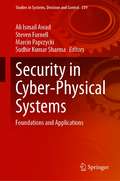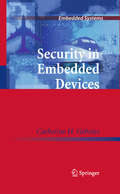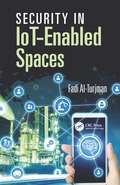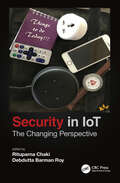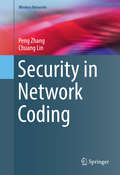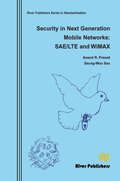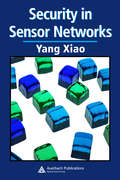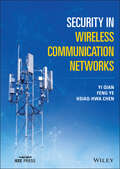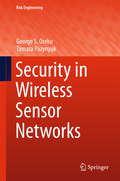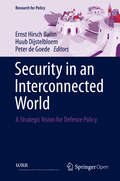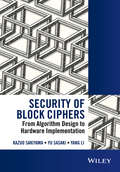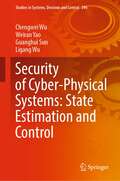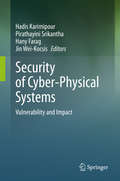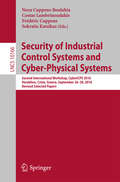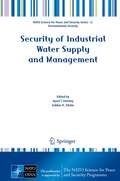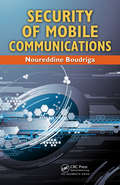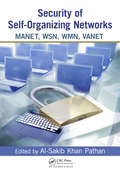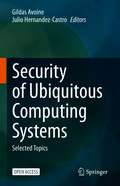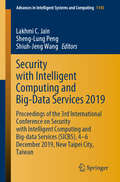- Table View
- List View
Security in Cyber-Physical Systems: Foundations and Applications (Studies in Systems, Decision and Control #339)
by Steven Furnell Ali Ismail Awad Marcin Paprzycki Sudhir Kumar SharmaThis book is a relevant reference for any readers interested in the security aspects of Cyber-Physical Systems and particularly useful for those looking to keep informed on the latest advances in this dynamic area.Cyber-Physical Systems (CPSs) are characterized by the intrinsic combination of software and physical components. Inherent elements often include wired or wireless data communication, sensor devices, real-time operation and automated control of physical elements. Typical examples of associated application areas include industrial control systems, smart grids, autonomous vehicles and avionics, medial monitoring and robotics. The incarnation of the CPSs can therefore range from considering individual Internet-of-Things devices through to large-scale infrastructures. Presented across ten chapters authored by international researchers in the field from both academia and industry, this book offers a series of high-quality contributions that collectively address and analyze the state of the art in the security of Cyber-Physical Systems and related technologies. The chapters themselves include an effective mix of theory and applied content, supporting an understanding of the underlying security issues in the CPSs domain, alongside related coverage of the technological advances and solutions proposed to address them. The chapters comprising the later portion of the book are specifically focused upon a series of case examples, evidencing how the protection concepts can translate into practical application.
Security in Distributed, Grid, Mobile, and Pervasive Computing
by Yang XiaoThis book addresses the increasing demand to guarantee privacy, integrity, and availability of resources in networks and distributed systems. It first reviews security issues and challenges in content distribution networks, describes key agreement protocols based on the Diffie-Hellman key exchange and key management protocols for complex distributed systems like the Internet, and discusses securing design patterns for distributed systems. The next section focuses on security in mobile computing and wireless networks. After a section on grid computing security, the book presents an overview of security solutions for pervasive healthcare systems and surveys wireless sensor network security.
Security in Embedded Devices
by Catherine H. GebotysAlthough security is prevalent in PCs, wireless communications and other systems today, it is expected to become increasingly important and widespread in many embedded devices. For some time, typical embedded system designers have been dealing with tremendous challenges in performance, power, price and reliability. However now they must additionally deal with definition of security requirements, security design and implementation. Given the limited number of security engineers in the market, large background of cryptography with which these standards are based upon, and difficulty of ensuring the implementation will also be secure from attacks, security design remains a challenge. This book provides the foundations for understanding embedded security design, outlining various aspects of security in devices ranging from typical wireless devices such as PDAs through to contactless smartcards to satellites.
Security in IoT-Enabled Spaces
by Fadi Al-TurjmanSecurity and smart spaces are among the most significant topics in IoT nowadays. The implementation of secured smart spaces is at the heart of this concept, and its development is a key issue in the next generation IoT. This book addresses major security aspects and challenges in realizing smart spaces and sensing platforms in critical Cloud and IoT applications. The book focuses on both the design and implementation aspects of security models and strategies in smart that are enabled by wireless sensor networks and RFID systems. It mainly examines seamless data access approaches and encryption and decryption aspects in reliable IoT systems.
Security in IoT: The Changing Perspective
by Rituparna Chaki Debdutta Barman RoyThe diverse applications of IoT are achieved by a set of complex inter-related networks of things and communications. IoT applications are also concerned about an array of devices such as sensors, mobile devices, personal computers, the smart systems such as Alexa, Eco, etc, besides the whole range of communication network binding them together in a seamless manner. This book explores the variegated perspectives of security in the complex context of Internet of Things. It also aims to present the changing face of security, from the ubiquitous networks comprising of WSN as the lowest layer, to the enabler apps working as bridge between the users and the complex IoT system. It takes a closer look at the different types of security schemes required to fit in the heterogeneous nature of IoT network., whilst the readers are also introduced to basic attacks targeting an IoT network, as well as specific types of security schemes worked out by researchers across different countries. As Programmable Logic Controllers (PLC) play a fundamental role in Industrial Control Systems, since they provide various functionalities of physical tools by collecting data from input devices and sending commands to output devices, this book includes a discussion on the security considerations of extending a PLC-based system with IoT capabilities. Other advanced topics include: The machine ethics aspects in the IoT system; the Intrusion detection of WSN; and the methods of securing the user from privacy breaches due to the overprivileged IoT apps. This book will be beneficial to any readers interested in security of IoT systems and how to develop a layer-wise security scheme for such a system.
Security in Network Coding
by Peng Zhang Chuang LinThis book covers a series of security and privacy issues in network coding, and introduces three concrete mechanisms to address them. These mechanisms leverage traditional cryptographic primitives and anonymous protocols, and are redesigned to fit into the new framework of network coding. These three mechanisms are MacSig, a new message authentication method for network-coded systems; P-Coding, a new encryption scheme to secure network-coding-based transmissions; and ANOC, a new anonymous routing protocol that seamlessly integrates anonymous routing with network coding. Along with these three mechanisms, the authors provide a review of network coding's benefits, applications, and security problems. Also included is a detailed overview of security issues in the field, with an explanation of how the security issues differ from those in traditional settings. While network coding can help improve network performance, the adoption of network coding can be greatly limited unless security and privacy threats are addressed. Designed for researchers and professionals, Security in Network Coding explores major challenges in network coding and offers practical solutions. Advanced-level students studying networking or system security will also find the content valuable.
Security in Next Generation Mobile Networks: SAE/LTE and Wimax (River Publishers Series In Standardisation Ser.)
by Anand R. Prasad Seung-Woo SeoStarting from voice services with simple terminals, today a mobile device is nothing sort of a small PC in the form of smart-phones. The result has been a huge increase in data-services giving mobile communication access to critical aspects of human society / life. This has led to standardization of SAE/LTE (System Architecture Evolution / Long Term Evolution) by 3GPP and IEEE 802.16e / WiMAX. Together with penetration of mobile communications and new standardization come new security issues and thus the need for new security solutions. This book provides a fresh look at those security aspects, with main focus on the latest security developments of 3GPP SAE/LTE and WiMAX. SAE/LTE is also known as Evolved Packet System (EPS).The intended audience for this book is mobile network and device architects, designers, researchers and students. The goal of the authors, who have a combined experience of more than 25 years in mobile security standardization, architecture, research, and education, is to provide the book?s readers with a fresh and up-to-date look at the architecture and challenges of EPS and WiMAX security.
Security in RFID and Sensor Networks
by Paris Kitsos Yan ZhangIn the past several years, there has been an increasing trend in the use of Radio Frequency Identification (RFID) and Wireless Sensor Networks (WSNs) as well as in the integration of both systems due to their complementary nature, flexible combination, and the demand for ubiquitous computing. As always, adequate security remains one of the open are
Security in Sensor Networks
by Yang XiaoSensor networks differ from traditional networks in many aspects including their limited energy, memory space, and computational capability. These differentiators create unique security vulnerabilities. Security in Sensor Networks covers all aspects of the subject, serving as an invaluable reference for researchers, educators, and practition
Security in Smart Home Networks (Wireless Networks)
by Haojin Zhu Xuemin (Sherman) Shen Yan MengThis book presents the security and privacy challenges of the smart home following the logic of “terminal device – voice interface – application platform”. For each component, the authors provide answers to the three questions: 1) In the terminal device layer, how to conduct cross-layer privacy breach analysis and provide effective countermeasures; 2) In the voice interface layer, how to design effective and lightweight schemes to defend against voice spoofing; 3) In the application layer, how to design an effective anomaly detection system without breaching the application platform. The authors conduct a thorough analysis of the security threats and challenges in each component of the smart home, review the existing state-of-the-art solutions proposed by other researchers, and elaborate on proposed countermeasures. This book aims to provide both security threats analysis and state-of-the-art countermeasures for the smart home network.
Security in Wireless Communication Networks (IEEE Press)
by Yi Qian Feng Ye Hsiao-Hwa ChenReceive comprehensive instruction on the fundamentals of wireless security from three leading international voices in the field Security in Wireless Communication Networksdelivers a thorough grounding in wireless communication security. The distinguished authors pay particular attention to wireless specific issues, like authentication protocols for various wireless communication networks,encryption algorithms and integrity schemes on radio channels, lessons learned from designing secure wireless systems and standardization for security in wireless systems. The book addresses how engineers, administrators, and others involved in the design and maintenance of wireless networks can achieve security while retaining the broadcast nature of the system, with all of its inherent harshness and interference. Readers will learn: A comprehensive introduction to the background of wireless communication network security, including a broad overview of wireless communication networks, security services, the mathematics crucial to the subject, and cryptographic techniques An exploration of wireless local area network security, including Bluetooth security, Wi-Fi security, and body area network security An examination of wide area wireless network security, including treatments of 2G, 3G, and 4G Discussions of future development in wireless security, including 5G, and vehicular ad-hoc network security Perfect for undergraduate and graduate students in programs related to wireless communication, Security in Wireless Communication Networks will also earn a place in the libraries of professors, researchers, scientists, engineers, industry managers, consultants, and members of government security agencies who seek to improve their understanding of wireless security protocols and practices.
Security in Wireless Mesh Networks (Wireless Networks And Mobile Communications Ser.)
by Yan Zhang Jun Zheng Honglin HuWireless mesh networks (WMN) encompass a new area of technology set to play an important role in the next generation wireless mobile networks. WMN is characterized by dynamic self-organization, self-configuration, and self-healing to enable flexible integration, quick deployment, easy maintenance, low costs, high scalability, and reliable services.
Security in Wireless Sensor Networks
by George S. Oreku Tamara PazynyukThis monograph covers different aspects of sensor network security including new emerging technologies. The authors present a mathematical approach to the topic and give numerous practical examples as well as case studies to illustrate the theory. The target audience primarily comprises experts and practitioners in the field of sensor network security, but the book may also be beneficial for researchers in academia as well as for graduate students.
Security in an Interconnected World: A Strategic Vision for Defence Policy (Research for Policy)
by Huub Dijstelbloem Ernst Hirsch Ballin Peter De GoedeThis open access book follows the idea that security policy must be based on strategic analysis. Defence policy and the role of the armed forces can subsequently be determined on the grounds of said analysis. More than ever, internal and external security, and developments both in the Netherlands and abroad are interconnected. The world order is shifting, the cooperation within NATO and the EU is under pressure and the Dutch armed forces are gasping for breath. What is the task of Dutch security and the defence policy? There have been growing calls in the last few years to end the devastating cuts in the defence budget and to invest more in security. The acute threats and conflicts in which the Netherlands are involved have served as a wake-up call. The shooting down of Flight MH17 over Ukraine, the streams of refugees from Syria and other countries, the conflict with Da’esh in Syria and Iraq, and terrorist threats reveal how events in many of the world’s flash-points have a direct or indirect impact on the Netherlands. Conflicts in other countries have a spill-over effect in The Netherlands. This is illustrated by tensions between population groups and the clashes over the Gülen schools after the failed putsch in Turkey on 15 July 2016 and over the constitutional referendum in that country. How do we ensure that any additional funds are not divided amongst the branches of the armed forces without any sense of strategic direction? What should a future-proof security policy that plots the course of defence policy entail? What strategic analyses should lie behind the political choices that are made? This book answers these questions and offers a comprehensive framework addressing among other things human security, national security and flow security.
Security of Biochip Cyberphysical Systems
by Krishnendu Chakrabarty Ramesh Karri Shayan Mohammed Sukanta Bhattacharjee Yong-Ak SongThis book provides readers with a valuable guide to understanding security and the interplay of computer science, microfluidics, and biochemistry in a biochip cyberphysical system (CPS). The authors uncover new, potential threat and trust-issues to address, as this emerging technology is poised to be adapted at a large scale. Readers will learn how to secure biochip CPS by leveraging the available resources in different application contexts, as well as how to ensure intellectual property (IP) is protected against theft and counterfeits. This book enables secure biochip CPS design by helping bridge the knowledge gap at the intersection of the multi-disciplinary technology that drives biochip CPS.
Security of Block Ciphers: From Algorithm Design to Hardware Implementation (Wiley - IEEE)
by Yang Li Kazuo Sakiyama Yu SasakiA comprehensive evaluation of information security analysis spanning the intersection of cryptanalysis and side-channel analysis Written by authors known within the academic cryptography community, this book presents the latest developments in current research Unique in its combination of both algorithmic-level design and hardware-level implementation; this all-round approach - algorithm to implementation – covers security from start to completion Deals with AES (Advanced Encryption standard), one of the most used symmetric-key ciphers, which helps the reader to learn the fundamental theory of cryptanalysis and practical applications of side-channel analysis
Security of Cyber-Physical Systems: State Estimation and Control (Studies in Systems, Decision and Control #396)
by Ligang Wu Guanghui Sun Chengwei Wu Weiran YaoThis book analyzes the secure problems of cyber-physical systems from both the adversary and defender sides. Targeting the challenging security problems of cyber-physical systems under malicious attacks, this book presents some recent novel secure state estimation and control algorithms, in which moving target defense scheme, zero-sum game-theoretical approach, reinforcement learning, neural networks, and intelligent control are adopted. Readers will find not only the valuable secure state estimation and control schemes combined with the approaches aforementioned, but also some vital conclusions for securing cyber-physical systems, for example, the critical value of allowed attack probability, the maximum number of sensors to be attacked, etc. The book also provides practical applications, example of which are unmanned aerial vehicles, interruptible power system, and robot arm to validate the proposed secure algorithms. Given its scope, it offers a valuable resource for undergraduate and graduate students, academics, scientists, and engineers who are working in this field.
Security of Cyber-Physical Systems: Vulnerability and Impact
by Hadis Karimipour Pirathayini Srikantha Hany Farag Jin Wei-KocsisThis book presents a comprehensive overview of security issues in Cyber Physical Systems (CPSs), by analyzing the issues and vulnerabilities in CPSs and examining state of the art security measures. Furthermore, this book proposes various defense strategies including intelligent attack and anomaly detection algorithms.Today’s technology is continually evolving towards interconnectivity among devices. This interconnectivity phenomenon is often referred to as Internet of Things (IoT). IoT technology is used to enhance the performance of systems in many applications. This integration of physical and cyber components within a system is associated with many benefits; these systems are often referred to as Cyber Physical Systems (CPSs).The CPSs and IoT technologies are used in many industries critical to our daily lives. CPSs have the potential to reduce costs, enhance mobility and independence of patients, and reach the body using minimally invasive techniques. Although this interconnectivity of devices can pave the road for immense advancement in technology and automation, the integration of network components into any system increases its vulnerability to cyber threats. Using internet networks to connect devices together creates access points for adversaries. Considering the critical applications of some of these devices, adversaries have the potential of exploiting sensitive data and interrupting the functionality of critical infrastructure.Practitioners working in system security, cyber security & security and privacy will find this book valuable as a reference. Researchers and scientists concentrating on computer systems, large-scale complex systems, and artificial intelligence will also find this book useful as a reference.
Security of FPGA-Accelerated Cloud Computing Environments
by Jakub Szefer Russell TessierThis book addresses security of FPGA-accelerated cloud computing environments. It presents a comprehensive review of the state-of-the-art in security threats as well as defenses. The book further presents design principles to help in the evaluation and designs of cloud-based FPGA deployments which are secure from information leaks and potential attacks.
Security of Industrial Control Systems and Cyber-Physical Systems
by Nora Cuppens-Boulahia Frédéric Cuppens Sokratis Katsikas Costas LambrinoudakisThis book constitutes the refereed proceedings of the First Conference on Cybersecurity of Industrial Control Systems, CyberICS 2015, and the First Workshop on the Security of Cyber Physical Systems, WOS-CPS 2015, held in Vienna, Austria, in September 2015 in conjunction with ESORICS 2015, the 20th annual European Symposium on Research in Computer Security. The 6 revised full papers and 2 short papers of CyberICS 2015 presented together with 3 revised full papers of WOS-CPS 2015 were carefully reviewed and selected from 28 initial submissions. CyberICS 2015 focuses on topics covering ICSs, including cyber protection and cyber defense of SCADA systems, plant control systems, engineering workstations, substation equipment, programmable logic controllers, PLCs, and other industrial control system. WOS-CPS 2015 deals with the Security of Cyber Physical Systems, that exist everywhere around us, and range in size, complexity and criticality, from embedded systems used in smart vehicles, to SCADA systems in smart grids to control systems in water distribution systems, to smart transportation systems etc.
Security of Industrial Water Supply and Management
by Subhas K. Sikdar Aysel T. AtimtayOver time, the increased use of fresh water for agriculture and industry together with contamination from discharges of pollutants, mean that ever more areas of the planet are becoming water-stressed. Because of the competing needs of communities and industry for fresh water, industry will be challenged to meet its growing demands for water, which is essential for producing the goods and services that would boost human welfare. Thus industry will need to learn how to cost-effectively purify and recycle its wastewater for reuse, ultimately approaching a net zero-discharge condition. The chapters in this book, written by international experts, treat the technical issues of such treatment and water management, and also provide guidance on technologies, either existing or in development, that can potentially achieve the goal of recycle-reuse. The book will serve as a useful reference for academics, government and industry professionals alike.
Security of Mobile Communications
by Noureddine BoudrigaThe explosive demand for mobile communications is driving the development of wireless technology at an unprecedented pace. Unfortunately, this exceptional growth is also giving rise to a myriad of security issues at all levels-from subscriber to network operator to service provider. Providing technicians and designers with a critical and comprehens
Security of Self-Organizing Networks: MANET, WSN, WMN, VANET
by AI-Sakib Khan PathanReflecting recent advancements, Security of Self-Organizing Networks: MANET, WSN, WMN, VANET explores wireless network security from all angles. It begins with a review of fundamental security topics and often-used terms to set the foundation for the following chapters. Examining critical security issues in a range of wireless networks, the bo
Security of Ubiquitous Computing Systems: Selected Topics
by Gildas Avoine Julio Hernandez-CastroThe chapters in this open access book arise out of the EU Cost Action project Cryptacus, the objective of which was to improve and adapt existent cryptanalysis methodologies and tools to the ubiquitous computing framework. The cryptanalysis implemented lies along four axes: cryptographic models, cryptanalysis of building blocks, hardware and software security engineering, and security assessment of real-world systems.The authors are top-class researchers in security and cryptography, and the contributions are of value to researchers and practitioners in these domains.This book is open access under a CC BY license.
Security with Intelligent Computing and Big-Data Services 2019: Proceedings of the 3rd International Conference on Security with Intelligent Computing and Big-data Services (SICBS), 4–6 December 2019, New Taipei City, Taiwan (Advances in Intelligent Systems and Computing #1145)
by Lakhmi C. Jain Sheng-Lung Peng Shiuh-Jeng WangThis book aims to attract researchers and practitioners who are working in Information Technology and Computer Science. This edited book is about basics and high level concepts regarding Blockchain Technology and Application, Multimedia Security, Information Processing, Security of Network, Cloud and IoT, Cryptography and Cryptosystem, Learning and Intelligent Computing, Information Hiding. It is becoming increasingly important to develop adaptive, intelligent computing-centric, energy-aware, secure and privacy-aware mechanisms in high performance computing and IoT applications. The book serves as a useful guide for industry persons and also helps beginners to learn things from basic to advance in the area of better computing paradigm. Our aim is intended to provide a platform for researchers, engineers, academicians as well as industrial professionals from all over the world to present their research results in security related areas. We believe that this volume not only presents novel and interesting ideas but also will stimulate interesting discussions from the participants and inspire new ideas.
